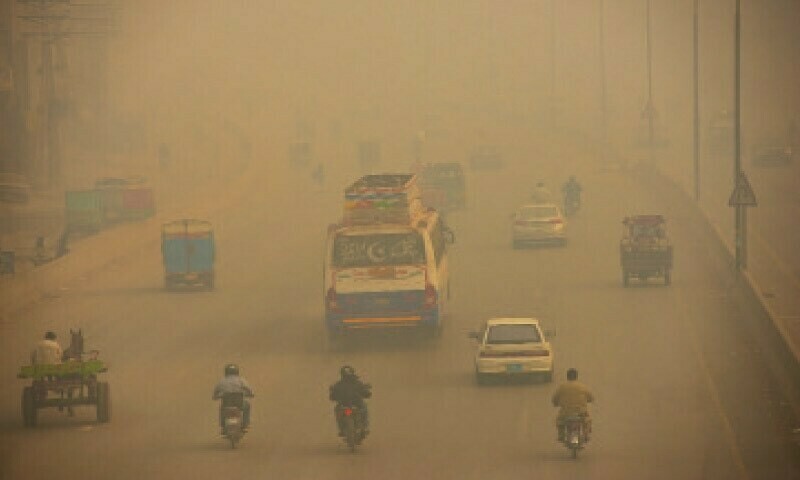
[ad_1]

In Syed Nagar near Alipur Chatta in the Gujranwala district, hapless families remain trapped in a cycle of polluted air, persistent foul odours, and low visibility, further worsening the already difficult lives of ordinary people.
A proper evaluation of air quality in this area is necessary to confirm the pollution levels, but the air likely contains harmful particles and chemicals, putting residents and their livestock, wildlife and plants at risk of various hazardous effects.
The struggles of residents in this quiet Punjab town due to poor air quality were first highlighted in these pages back in 2017. At that time, both the relevant authorities and the owners of lubricant factories pledged to address the issue. Unfortunately, seven years later, the situation has only deteriorated. Residents now report a rise in asthma cases, as well as eye and skin infections.
The residents of Syed Nagar are not alone; communities near industrial areas across Pakistan face a similar plight. In Karachi, areas like Korangi, home to two major refineries, as well as chemical, food, textile, tanneries, and leather factories, are among the hardest hit, with families quietly enduring the effects of pollution.
Companies start the long overdue process of waste management as air pollution worsens living conditions
According to a World Health Organisation report, “Dirty air is causing a global public health crisis. Every minute, a child dies from an illness caused by air pollution. Every minute, 10 adults die prematurely because of dirty air inhaled during their lifetime. The total, at least five million deaths annually, exceeds the combined yearly deaths from war, murder, car accidents, plane crashes, malaria, tuberculosis, HIV/AIDS, and Ebola combined.”
A World Bank publication highlights that Pakistan’s urban air pollution is among the most severe globally, causing substantial harm to both public health and the economy. Lahore currently ranks as the second worst city on the global air quality index, while Karachi stands 11th out of 120 cities assessed.
Several official reports recognise the poor air quality in Pakistan and highlight its sources and financial impact. An earlier report from the Environmental Protection Agency states, “The magnitude of industrial air pollution in Pakistan has not been comprehensively assessed, although sporadic surveys have been conducted by public institutions and scientists in a few major cities.”
Majyd Aziz, former president of UN Global Compact Network Pakistan, discussed the network’s efforts to raise business awareness by highlighting case studies of industries committed to achieving Net Zero emissions by 2030.
He noted that air emissions, primarily from boilers and generators, have long been an issue. In response to natural gas shortages, many textile mills in Punjab switched to alternative fuels like biomass and wood, a practice now being adopted by mills in Karachi. Some units also rely on domestic and imported coal for their boilers.
“Industries in Pakistan are notorious for not taking measures to control pollution. However, large industrialists, particularly in textiles, voluntarily or perforce because of overseas buyer demands, have invested in tackling the menace and projecting their units as environmentally friendly.
“Some industries are also repurposing smoke, fumes, and vapours to heat boilers and utilising emission control devices like scrubbers and catalytic converters to reduce harmful emissions.”
Khurram Mukhtar, Patron-in-Chief of the Pakistan Textile Exporters Association, emphasised the industry’s proactive response to environmental challenges. “We are investing in cleaner technologies, adopting energy-efficient processes, and transitioning towards the use of renewable energy where possible. Many companies are also enforcing stricter emissions controls and reducing waste and resource consumption.
He highlighted the growing collaboration between millers, government bodies, and environmental agencies to adopt sustainable practices and comply with environmental regulations.
“The use of coal in Punjab has significantly decreased, with biofuels being used instead. Many companies have also signed on to the Net Zero initiative, demonstrating their collective responsibility.”
Ehsan Malik, CEO of the Pakistan Business Council (PBC), emphasised that most formal businesses now prioritise environmental responsibility. PBC’s Centre of Excellence in Responsible Business (CERB) is helping companies align with global environmental and social governance (ESG) standards, which extend beyond air pollution.
Companies are required to report their carbon footprints under the International Financial Reporting Standards, and banks, under State Bank guidelines, ensure clients meet these standards. Larger companies are also enforcing similar practices across their supply chains, driven by export demands for reduced carbon footprints.
Mr Malik noted that the European Union’s (EU) upcoming Carbon Border Adjustment Mechanism will tax items that fail to meet environmental standards, pushing exporters under the EU Generalised Scheme of Preferences Plus to comply. “PBC is launching a portal where companies can share their ESG progress, offering valuable models for others to follow.” He stated that climate change affects everyone and that collective efforts will benefit all.
Abdul Aleem, Secretary General, Overseas Investors Chamber of Commerce and Industry, noted that all members comply with the National Environmental Quality Standards and provincial regulations. “Companies are actively monitoring their Scope 1 and 2 emissions and focusing on Scope 3 emissions to address broader environmental impacts.”
He highlighted that industries are investing in emission control equipment and focusing on energy conservation through initiatives like solarisation, renewable energy, water conservation, and route optimisation. Many organisations have established operational sustainability key performance indicators aimed at reducing waste, conserving natural resources, and fostering biodiversity to act as carbon sinks.
Published in Dawn, The Business and Finance Weekly, October 14th, 2024
[ad_2]
Source link






